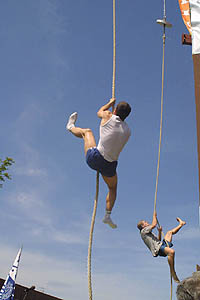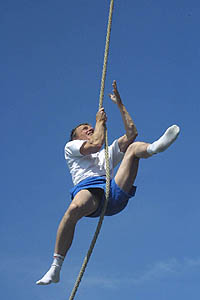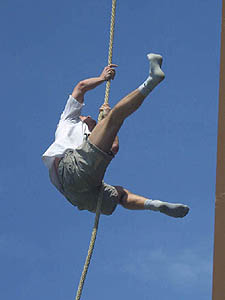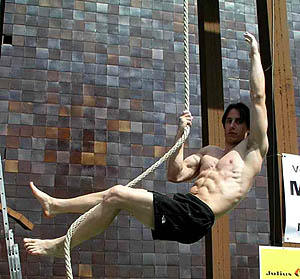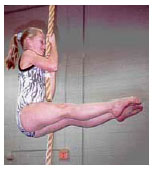|
A New Age for Rope Climbing . . . In 1993 Competitive
Rope
Climbing was resurrected in the Czech
Republic.
Contests are conducted at regional and national levels on the 8 meter rope. The following photos are courtesy of Jiří Tlamsa. http://www.svetsplhu.wz.cz/
. .
.
Several of the Many Competitors in the Czech Republic
. . . Winning times for the B. Šupčika Memorial Competition 8 Meter Rope
|
Personal
Commentary . . .
.
. .
I got started climbing rope and working the still and flying rings after I had finished the required gymnastics course at Georgia Tech, and began occasional practices with several members of the Tech Gymnastics Squad. Lyle Welser, the coach, encouraged me to do this. I didn't really feel competent, however, until I was well into my sophomore year. At the end of that year I transferred to the University of Georgia , which had a better pure mathematics program, but no gymnastics team - even though the appartus was available. At UGA I got a very small group of "stranded" male gymnasts together as an informal club and we met several times a week to work out during 1956 - 1958. My fastest recorded time on the 20' climb - hands only from a seated position on the floor - 3.4 seconds - was at the University of Georgia in 1958. My father - a professor at the University - held one of the stopwatches. The next year I climbed rope, worked out on the still rings, and helped out a little with Coach Bob Kreidler's University of Chicago team as I studied meteorology for the USAF. I never recorded a better time on the rope, so I probably never broke the 3 second barrier. By 1967 I had stopped doing the climb. I remember two of the rope climbers at Tech when I was there: The late "Bo" Stokes and Jack Keen. Jack, one year my senior, was a pole vaulter as well as a gymnast. When he wasn't pole vaulting or throwing the javelin, he would wander into the gym, pull a perfect front lever on the horizontal bar, and fly up the rope several times. Although I don't recall him being faster than Bo, his style was extremely impressive due to his incredible strength. Back outside, he would frequently walk a barrel upon which he was doing a handstand down the length of the football field. I heard that Jack took the Army Fitness Test and set a new record. On campus, his name inspired a certain awe, if not outright hero-worship! He got a degree in Industrial Management, then became a high school coach, founded the Atlanta Track Club, and upon retirement in 2003 was named to the Georgia Athletic Coaches Association Hall of Fame. He was also a mathematics teacher and was named Star Teacher of the Year 27 times at Jefferson High, near Athens. . .
.
Perhaps women could do well in this forgotten sport . . . female circus performers regularly climb ropes or poles, and candidates for women's elite gymnastic status here in America are required to climb a 6 to 13 foot rope with legs held in the L-position. See the panel to the right for details. Furthermore, the putative "world record" - established in Philadelphia in 1918 - for consecutive one-arm pull-ups (27) is held by a female circus performer from that era: Lillian Leitzel (1892-1931). Her circus routine was done on a single suspended ring or rope, from which she did various stunts hanging from one arm. She was 4'9" tall and weighed 95 pounds. However, an analysis reveals she almost certainly used swinging body momentum similar to her ring routine to achieve her record. Since 1918 no female gymnast has done more than 6 one-arm chins consecutively. For further information on these kinds of strength feats, go to: |
National
Elite Physical Abilities Testing - Female Gymnasts Rope Climb
The
gymnast
starts by sitting in a piked position (legs together with the rope to the side)
on a mat • Legs
slightly bent during the test – add 1 second • Legs
severely bent during the test – add 2 seconds • Legs
apart during the test – add 1 second • Legs
falling briefly below horizontal, but not lower than 45° below
horizontal – add
1 • Legs
falling below 45 degrees from horizontal during the test add 2 seconds • If a
gymnast uses her legs to facilitate the climb, her score
will be a zero. • If a
gymnast fails to reach the 13’ mark, her score will be zero. • Penalties
can be taken and can accumulate from different categories (i.e. bent
legs and To receive a perfect score of
"10", the gymnast must score a time of 4.99 seconds or less.
USA
Gymnastics
|
| one arm rope climb from www. crossfit.com |
